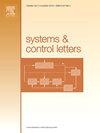Identifiable specializations for ODE models
IF 2.5
3区 计算机科学
Q3 AUTOMATION & CONTROL SYSTEMS
引用次数: 0
Abstract
The parameter identifiability problem for a dynamical system is to determine whether the parameters of the system can be found from data for the outputs of the system. Verifying whether the parameters are identifiable is a necessary first step before a meaningful parameter estimation can take place. Non-identifiability occurs in practical models. To reparametrize a model to achieve identifiability is a challenge. The existing approaches have been shown to be useful for many important examples. However, these approaches are either limited to linear models and scaling parametrizations or are not guaranteed to find a reparametrization even if it exists. In the present paper, we prove that there always exists a locally identifiable model with the same input–output behavior as the original one obtained from a given one by a partial specialization of the parameters. Our result applies to parametric rational ODE models with or without input, and our algorithm can find non-scaling reparametrizations. As an extra feature of our approach, the resulting (at least) locally identifiable reparametrization has the same shape: the monomials in the new state variables in the new model are formed in the same way as in the original model. Furthermore, we give a sufficient observability condition for the existence of a state space transformation from the original model to the new one. Our proof is constructive and can be translated to an algorithm, which we illustrate by several examples, with and without inputs.
ODE模型的可识别专门化
动态系统的参数可辨识性问题是确定是否可以从系统输出的数据中找到系统的参数。在进行有意义的参数估计之前,验证参数是否可识别是必要的第一步。不可识别性出现在实际模型中。重新参数化模型以实现可识别性是一个挑战。现有的方法已被证明对许多重要的例子是有用的。然而,这些方法要么局限于线性模型和缩放参数化,要么不能保证找到一个重新参数化,即使它存在。在本文中,我们证明了总存在一个局部可识别的模型,其输入输出行为与由给定模型通过参数的部分专门化得到的原始模型相同。我们的结果适用于有或没有输入的参数化有理ODE模型,并且我们的算法可以找到非标度的再参数化。作为我们方法的一个额外特征,结果(至少)局部可识别的再参数化具有相同的形状:新模型中新状态变量中的单项式以与原始模型相同的方式形成。进一步给出了从原模型到新模型状态空间变换存在的充分可观测条件。我们的证明是建设性的,可以转化为一个算法,我们用几个例子来说明,有和没有输入。
本文章由计算机程序翻译,如有差异,请以英文原文为准。
求助全文
约1分钟内获得全文
求助全文
来源期刊

Systems & Control Letters
工程技术-运筹学与管理科学
CiteScore
4.60
自引率
3.80%
发文量
144
审稿时长
6 months
期刊介绍:
Founded in 1981 by two of the pre-eminent control theorists, Roger Brockett and Jan Willems, Systems & Control Letters is one of the leading journals in the field of control theory. The aim of the journal is to allow dissemination of relatively concise but highly original contributions whose high initial quality enables a relatively rapid review process. All aspects of the fields of systems and control are covered, especially mathematically-oriented and theoretical papers that have a clear relevance to engineering, physical and biological sciences, and even economics. Application-oriented papers with sophisticated and rigorous mathematical elements are also welcome.
 求助内容:
求助内容: 应助结果提醒方式:
应助结果提醒方式:


